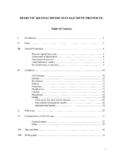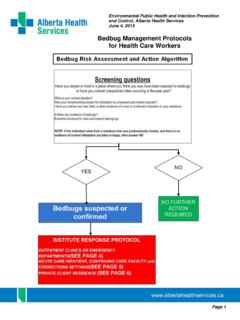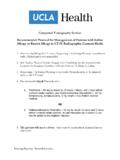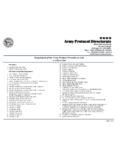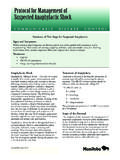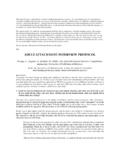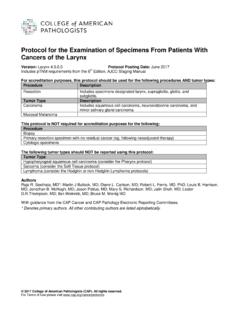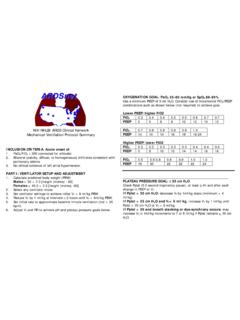Transcription of Reduce the Risks of Anesthesia for the Patient with ...
1 Anesthesia protocol for OSA Reduce the Risks of Anesthesia for the Patient with obstructive sleep Apnea (OSA) Derek J. Sakata, MD obstructive sleep apnea (OSA) is an increasingly common sleep disorder, which is of particular concern to anesthesiologists because it is associated with increased perioperative morbidity and Up to 24% of men and 9% of women suffer from ,3 OSA occurs two times more often in adults older than In obese adults (BMI 30), the reported prevalence of OSA is ~40%5; in extremely obese adults (BMI 40), the prevalence increases to 98%6. It is estimated that 80% to 90% of patients with OSA are undiagnosed; making them very difficult to The concerns in patients with OSA include potential upper-airway obstruction, difficult tracheal intubation and postoperative respiratory depression and airway Development of protocols for adequate preoperative evaluation of patients with suspected OSA is important. Although polysomnography remains the gold standard in the diagnosis of OSA, it may not always be available.
2 A presumptive diagnosis of OSA can be derived from abnormal breathing during sleep ( , loud snoring and witnessed apnea), frequent arousals ( , periodic extremity twitching, vocalization, turning and snorting) and excessive daytime sleepiness as well as a body mass index of >35 kg/m2, increased neck circumference (>17 inches for males and >16 inches for females) and presence of comorbidities ( , systemic hypertension, pulmonary hypertension, cardiomegaly). These symptoms and signs, however, do not reliably predict presence or severity of OSA. Therefore it is essential to treat patients with presumptive diagnosis of OSA as if they have severe Numerous studies have confirmed the complexity of the respiratory management of these patients during and after Anesthesia with emphasis on special needs for these patients to prevent or minimize respiratory complications. In addition, OSA is considered a risk factor for perioperative morbidity and In a study by Rakesh M. Gupta, et al.
3 , the overall incidence of postoperative complications was significantly higher in the OSA patients compared with the control patients . A significantly higher percentage of patients with OSA suffered serious complications or needed unplanned ICU transfers compared with the control patients . The study also found that most complications occur in the first 24 hours and stated that this may be due to the combined effect of anesthetic agents, sedatives, and narcotics, which tend to relax upper airway dilator muscles and increase upper airway resistance, thus aggravating Tzabar also showed that the effects of general Anesthesia persist beyond 24 hours7 and Benumof concluded that opioid administration in the presence of volatile anesthetics in the postoperative period contributes to depression of Miller confirmed that hypoventilation is commonly related to residual inhalation Extubation is a critical time in the management of known or suspected OSA patients and the potential for loss of airway control is First, whenever the Patient is to be the Patient should be fully awake; this means the Patient should be rational, oriented and responding to commands in a clear, crisp and unambiguous manner.
4 A dangerous mistake is to interpret mindless movement, such as reflex reaching for an endotracheal tube, or suddenly trying to sit up, for purposeful Deep extubation is not an option for the apnea Patient . The hazards include not only loss of airway control but also the risk of post- obstructive pulmonary edema as the Patient generates negative pressure trying to breathe against a closed glottis or collapsed airway. Adequate muscular tone of the upper airway should be present before the endotracheal tube is removed. Therefore, the Patient must be sufficiently awake prior to The association among severe obesity, sleep apnea, and difficult airway management further complicates airway management at induction and emergence from Prior to extubation, the Patient should be fully Anesthesia protocol for OSA The Anecare QED-100TM allows for partial re-breathing of CO2 to speed anesthetic clearance from the brain and increase spontaneous respiration. Simultaneously, the Anesthesia provider can hyperventilate the Patient to rapidly remove anesthetic from the arterial blood via the lungs.
5 The QED-100 works with isoflurane, sevoflurane, and desflurane. Eger writes that the decrease in PaCO2 produced by hyperventilation decreases cerebral blood flow and, thus, lengthens the time constant for elimination of anesthetic from the central nervous system. This slows recovery. We can compensate by adding carbon dioxide to the inspired gases during hyperventilation at concentrations sufficient ( , 5%) to prevent a decrease in PaCO2. Such a strategy produces a more rapid recovery. 11 Reversing volatile anesthetics provides easier management of the OSA Patient , improves Patient safety, reduces risk of PACU complications, and speeds Patient discharge from PACU by 35%.12 Katznelson proved that by controlling CO2 levels and hyperventilating, patients had a much shorter stay in the OR and PACU. In the study, anesthetic rebound effect was absent and low agent concentrations persisted for the first 20 min of the recovery period in the PACU. This is significant because while Anesthesia providers are generally adept at waking patients up after Anesthesia , it is important that the OSA Patient also stays awake throughout their recovery.
6 STEP I: Preoperative Assessment of Patient Risk for OSA Development of protocols for adequate preoperative evaluation of patients with suspected OSA is is essential to treat patients with presumptive diagnosis of OSA as if they have severe OSA. Girish P. Joshi, , ASA Newsletter, January 2006, Volume 70, Number 1 The Snore Score is a useful tool to assess a Patient s risk for OSA. 1. Are you a loud and/or regular snorer? 2. Have you been observed to gasp or stop breathing during sleep ? 3. Do you feel tired or groggy upon awakening or do you awaken with a headache? 4. Are you often tired or fatigued during the wake time hours? 5. Do you fall asleep sitting, reading, watching TV or driving? 6. Do you often have problems with memory or concentration? If the Patient has one or more of these symptoms they are at higher risk for having OSA. If the Patient is also overweight, has a large neck, and/or has high blood pressure the risk is even greater. 2006 American sleep Apnea Association STEP II: Intraoperative Reversal of Volatile Anesthetics If it is determined that a Patient is at higher risk for OSA, it is recommended that all measures be taken to remove volatile anesthetics after completion of surgery.
7 It is suggested that providers use the Anecare QED-100TM to rapidly reverse volatile anesthetics to quickly restore airway reflexes, thereby decreasing the risk of aspiration, apnea, and re-intubation with a probable difficult airway. The QED-100 restores Patient airway reflexes quickly by: Increasing cerebral blood flow to accelerate brain washout of volatile anesthetic Increasing spontaneous respiration Allowing hyperventilation to eliminate arterial anesthetic through the lungs without lower PaCO2 and cerebral blood flow Absorbing volatile anesthetic to prevent anesthetic rebreathing Anesthesia protocol for OSA STEP III: Postoperative Care Postoperative complications include airway obstruction, oxygen desaturation and the need for reintubation as well as hypertension, dysrhythmias and need for admission. It is recommended that patients who use CPAP preoperatively should use CPAP postoperatively. CPAP, however, should be used only after patients are awake and alert.
8 It is observed that most significant postoperative complications in OSA patients usually occur within two hours after surgery. The ASA Practice Guidelines for the Perioperative Management of patients with obstructive sleep Apnea suggest that OSA patients be monitored for a median of three hours longer than their non-OSA counterparts before discharge from the facility. In addition, the monitoring should continue for a median of seven hours after the last episode of airway obstruction or hypoxemia while breathing room air in an unstimulated References 1. Joshi, Girish P., Are patients with obstructive sleep Apnea Syndrome Suitable for Ambulatory Surgery, ASA Newsletter. 2006 Jan; volume 70, Number 1 2. Benumof, Obesity, sleep Apnea, the Airway and Anesthesia , Current Opinion Anaesthesiology. 2004 Feb; 17(1):21-30 3. Gupta, Rakesh M., et al., Postoperative Complications in patients with obstructive sleep Apnea Syndrome Undergoing Hip or Knee Replacements: A Case-Control Study, Mayo Clinic Proceedings.
9 2001; 76:897-905 4. Bixler E, Vgontzas A, Ten Have T, Tyson K, Kales A., Effects of age on sleep apnea in men, Am J Respir Crit Care Med 1998;157:144 148, Kaw, et. al, Chest, 2006; 129:198-205 5. Young T, Shahar E, Nieto FJ, et al. Predictors of sleep -disordered breathing in community-dwelling adults: the sleep Heart Health Study. Arch Intern Med. 2002; 162:893-900 6. Valencia-Flores M., Orea A., Castano , et al. Prevalence of sleep apnea and electrocardiographic disturbances in morbidly obese patients . Obes. Res. 2000; 8:262-9 7. Y. Tzabar, A. J. Asbury and K. Millar, Cognitive failures after general anaesthesia for day-case surgery, British Journal of Anaesthesia, Vol 76, Issue 2 194-197 8. Kirk A. Miller, MD, Christopher P. Harkin, MD, and Peter L. Bailey, MD, Postoperative Tracheal Extubation, Anesth Analg 1995;80:149-72 9. Amy Lynn Meoli, , et al., Upper Airway Management of the Adult Patient with obstructive sleep Apnea in the Perioperative Period - Avoiding Complications, Report of the AASM Clinical Practice Review Committee, sleep , Vol.
10 26, No. 8, 2003 10. Roman Schumann, Stephanie B. Jones, Vilma E. Ortiz, Kathleen Connor, Istvan Pulai, Edwin T. Ozawa, Alan M. Harvey, Daniel B. Carr, Best Practice Recommendations for Anesthetic Perioperative Care and Pain Management in Weight Loss Surgery, Obesity Research, Vol. 13 No. 2, February 2005 11. Edmond I Eger II, MD, and Lawrence J. Saidman, MD; Anesth Analg 2005; 100:1020 33 12. Katznelson R, Minkovick L, Beattie S, Fedoroko L, Fisher J; Accelerated Recovery from Sevoflurane Anesthesia with Isocapnic Hyperpneoa; Anesth Analg. 2008; 106:486-491
